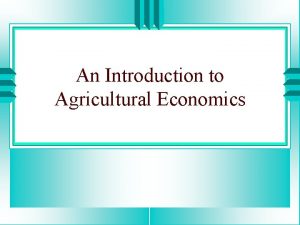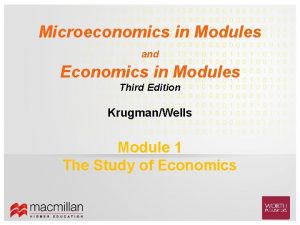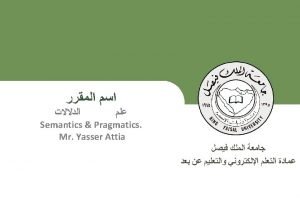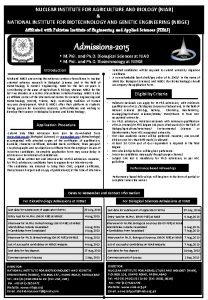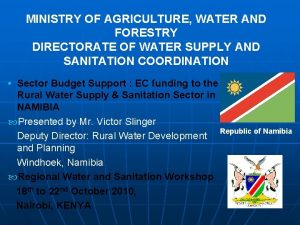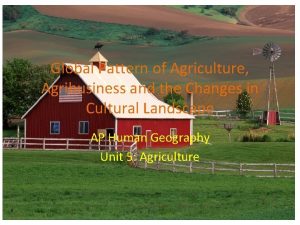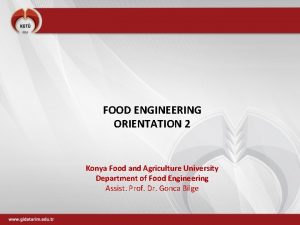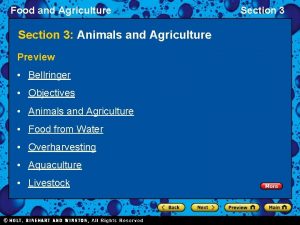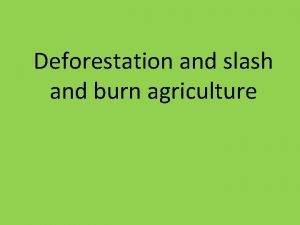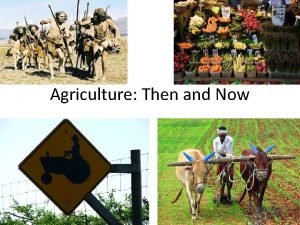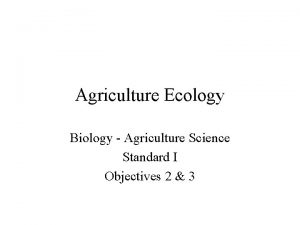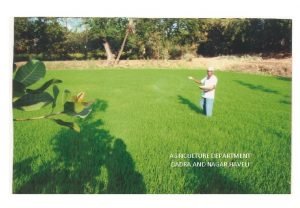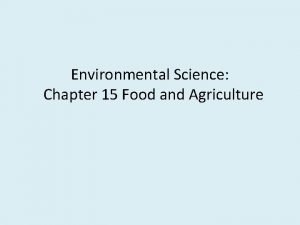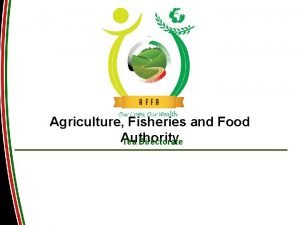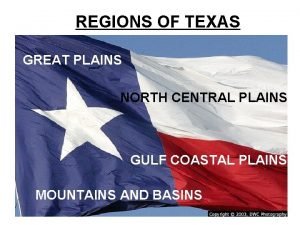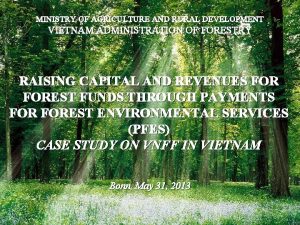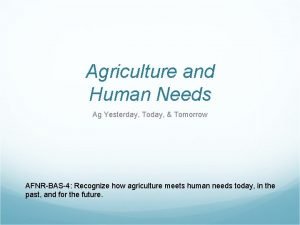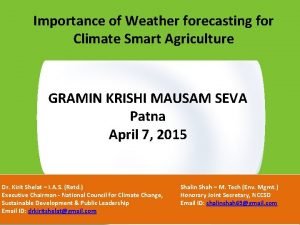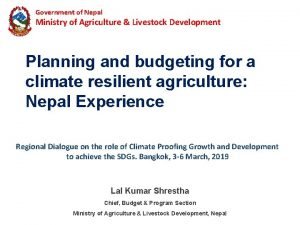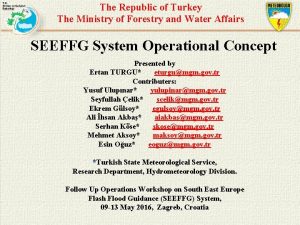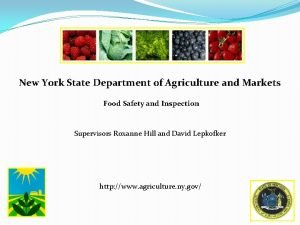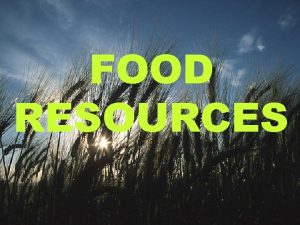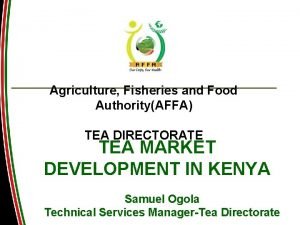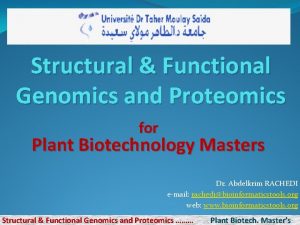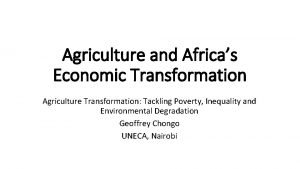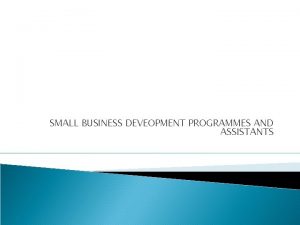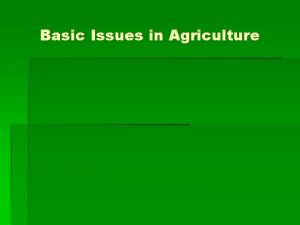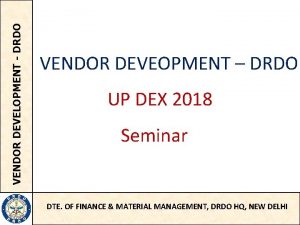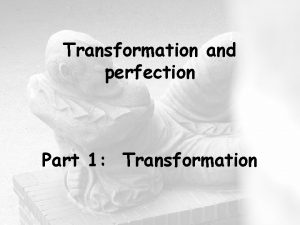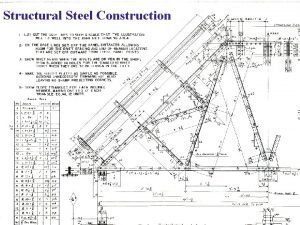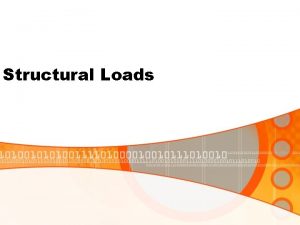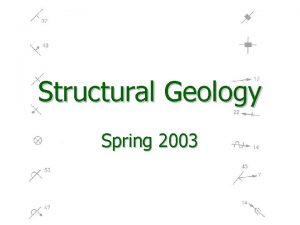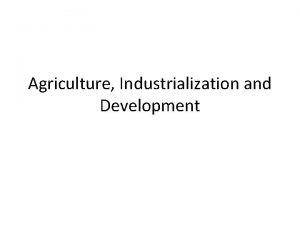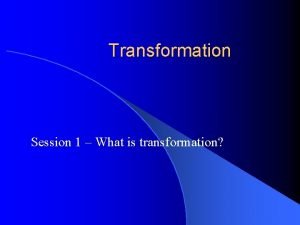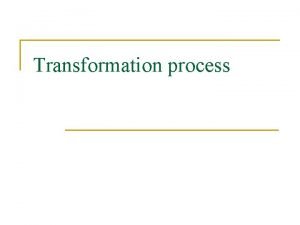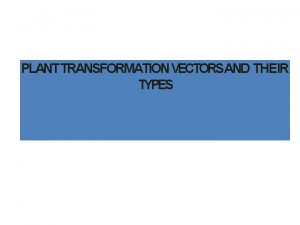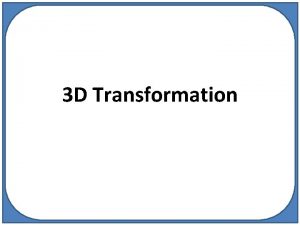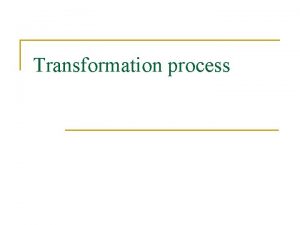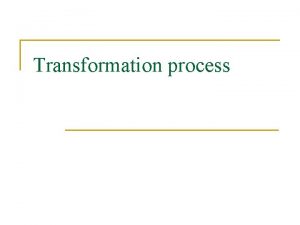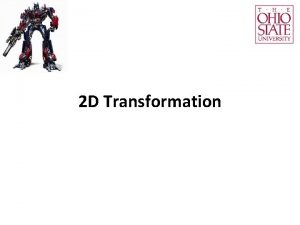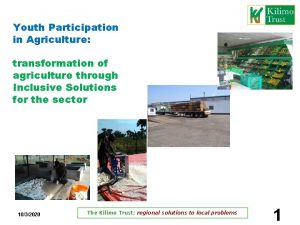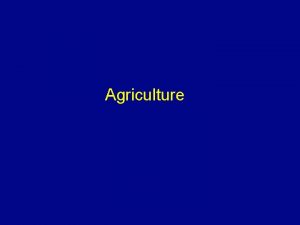Economic Deveopment and Structural Transformation of Agriculture Issues














































- Slides: 46

Economic Deveopment and Structural Transformation of Agriculture : Issues and Prospects Jung-Hwan Lee Vice-president, KREI

Contents 1. Introduction 2. Agriculture in the Korea Economy 3. Transformation of Agricultural Production 4. Transformation of Agricultural Employment 5. Transformation of Farm Land Transfer 6. Concluding Remarks and Implications

Ⅰ. Introduction ` Three Dimensions Adjustment of Agricultural Transformation of Agricultural Production from Traditional Commodities to Highly Income-Elastic and Exportable Commodities - Agricultural Growth Constrained by Supply-Side Factors in LICs by Demand-Side Factors in HICs

Reallocation of Labor Forces from Agriculture to Non-agriculture - Regulated by Job Change, Natural Factors, New Entrants Transfer of Farm Land Operationship form Small-Sized Farms to Large-Sized Farms

Ⅱ. Agriculture in `the Korea Economy 1. Transformation of Industrial Structure Agricultural Share has been Declining Trans. Point A Agriculture ≤ Service ≤ Manufacture Trans. Point B Agriculture A & B in Production ⇒ PA, PB A & B in Employment ⇒ EA, EB

Figure. Trans. of Industrial Structure in Korea <Employment Structure> Source: EPB. Annual Survey Report on the Economically Active Population Survey.

Figure. Trans. of Industrial Structure in Korea <Production Structure> Source : Bank of Korea(BOK), National Account.

Sequence of Transformation in Korea Table. Four Transformation Points & Time Lag Unit: % (Year)

International Comparison - Production Share

International Comparison - Employment Share

Table. The Year When the Ag. l Employment Ratio Reached 40 and 16 Percent

Table. The Year When the Ag. Pro. Share Reached 40 and 7 Percent - Transformation Point

Table. Agricultural Share at Trans. Points Unit: % Source : Lee and Timmer(1993)

- Time Lag between PA & EA, PB & EBTable. Time Lag in Industrial Trans.

2. Productivity Difference Proty Rate(Ag. Proty / Ag. Proty) in Korea Figure. Productivity Difference between Sectors

International Comparison ) 1 7 9 1 ( s t e n z u K ce n e r e f f i D y t i v i t c - Produ Decreases Ohkawa(1973) - Productivity Difference Increases Chenery(1986) - U-Shape

Industrial Structure & Turning Point

Ⅲ. Transformation of Agricultural` Production 1. Agricultural Growth in Korea Phases of Agriculture Growth Recovery 1990/92∼ 1995/97 2. 2% Negative Growth 1986/88∼ 1990/92 -0. 6% Slow Down 1975/77∼ 1986/88 1. 1% High Growth 1970/72∼ 1975/77 5. 8%

Contribution Rate by Commodity - High Growth by Rice & Vegetable, 4. 4%, 12. 4% - Slow Down by Rice & Grains, 0. 2%, -5. 0% - Negative Growth by Rice & Grains, -1. 7%, -5. 8% - Recovery by Vegetable & Livestock 4. 6%, 6. 7%

2. Transformation of Production Life Cycle of Demand for Agricultural Commodities - Luxury Goods⇒ Common Goods ⇒ Inferior Goods Life Cycle of Supply for Agricultural Commodities - Land Productivity ⇒ Labor Productivity - Mechanization or HVA Commodities

Figure. Growth of Land Labor Productivities in korean Agriculture Korea Failed in Timely Transformation of Agricultural Production

Ⅳ. Transformation of Agricultural Employment 1. Paths of Transformation of Employment Structure Job Change Three Paths of Transformation Death & Retirement Allocation of New Entrants

Job Change of Current Farm Labor Forces Table. Rate of Job Change from Ag. to Non-Ag. unit : % Source : Lee and Timmer (1993).

- Rate of Job Change by Age Group Table. Rate of Job Change of Agricultural Labor Force by Age unit : % - U-turn from Non-Agriculture

Sources of Decrease in Agricultural Labor Force: Dominated by Natural Factors Table. Sources of Decrease in Agricultural Labor Force unit : % Source : Lee and Timmer (1993).

2. Trans. of Age Structure of Ag. Labor Force Age Profile Curve shows Agricultural Share of Employment by Age Group Figure. Shift of Age Profile Curve of Ag. Labor Force in Korea - Share of New Entrant decrease more Fast - Job Change of Current Labor is very Low

Britain's Experience Figure. Shift of Age Profile Curve of Ag. Labor Force in Britain Source: Lee and Timmer(1993).

International Comparison Figure. Age Profile Curve of Ag. Labor Force: International Comparison in 1975 <Panel A> Source: Lee and Timmer(1993).

Figure. Age Profile Curve of Ag. Labor Force: International Comparison in 1975 <Panel B> Source: Lee and

Ⅴ. Transformation of Farm Land Transfer ` 1. Urban Land Market and Farm Land Price High Economic Growth Rate ⇒ Spurting Land Prices & Demand in Urban Areas ⇒ Increases of Farm Land Prices PA : Farm Land Price, RA : Farm Rent PN : Urban Land Price

Table. Land Price Index and Rate of Return to Farm Land in Korea Source : Lee J. H. et al. (1990), p. 63.

International Comparison Table. Rate of Rent Returns to Farm Land : International Comparison. Unit: % 1. * denote 1960 and 1980, respectively. Source : EUROSTAT and Dewit(1983). Lee J. H. et al. (1990), p. 63.

2. Development of Farmland Tenure System Land Reform Act(1949) - Farmland Distributed to Resident Farmers on an Equity Basis - 91. 9% of Total Farmland Att. to Owner Farms Tenant Farms Expanded since LRA - Tenant Farming Area : 43. 5% in 1997 - Farmland Transfer Depends on Lease

Table. Changes in Farm Size and dependence on Leases: A Case Study unit: % Source : Lee and Kim. (1984), p. 69 and 75.

Large-Sized Farms Depends on Lease Figure. Changes in Share of Rented Area by Farm Size <Korea> Source: MAF, Agricultural Census.

Figure. Changes in Share of Rented Area by Farm Size <Germany> Source: Koreanaga(1991), p. 155

Figure. Changes in Share of Rented Area by Farm Size <Japan> Source: MAF, Agricultural Census.

International Comparison Figure. Share of Rented Area by Farm Size in Developed Countries Sourece: Korenage(1991), p. 151 Why Lease is Prevailing? - High Farmland Price - Requirement of Farm Size Enlargement

3. Transformation of Farm Size Distribution Four Phases of Size Distribution in Korea - By the mid-1960 s - By the beginning 1980 s - From the end 1980 s Polarization Mid-size Concentration Upward Tilt Polarization Revived Figure. Changes in Farm Size Distribution in Korea

International Comparison (Polarization) ⇒ Mid Size Concentration ⇒ Upward Tilt ⇒ Polarization Figure. Changes in Farm Size Distribution in Japan Source : MAF, Statistical Yearbook on Agriculture and

Figure. Change in Farm Size Dist. in Netherlands Source: W. Huizinga & D. Strijiker(1986) and

Why Farm Size Dist Transformed? - In the Initial Stage of Economic Development Non-ag Employment Limited 2 nd or 3 rd Sons Turn very Small Size Owner / Tenant Farms or Laborers Large Size Farms depend on Cheap Laborers - Progress Stage of Economic Development Non-ag Employment Increases 2 nd or 3 rd Sons not Create New Farms Large Sized Farms Lease within Capacity of Family Labor(Cheap Farm Laborers not Available)

- Developed Stage Farm Mechanization Proceed and Part-Time Farming Available Large Size Farms Can Pay High Rent Large Size Concentration, Small Size Farms Sustain Table. Farm Size and Production Cost

Ⅱ. Agriculture in `the Korea Economy 1. Transformation Process of Agricultural Structure

2. Implications Hardship of Developing Countries New Income-Elastic Commodities Should be Developed before Demand for Traditional Stage Crops Slows Down Job-training and Retirement Program Should be Conducted to Boost Reallocation of Labor Force Farmland Lease System Should be Developed to Promote Farmland Transfer

Thank you! Korea Rural Economic Institute http: //www. krei. re. kr belmont@krei. re. kr
 Agricultural economics
Agricultural economics Prof. meier and baldwin
Prof. meier and baldwin Current problems of filipino entrepreneurs
Current problems of filipino entrepreneurs Economic problems
Economic problems Economic growth vs economic development
Economic growth vs economic development Chapter 1 lesson 2 our economic choices worksheet answers
Chapter 1 lesson 2 our economic choices worksheet answers Iron tools and agriculture
Iron tools and agriculture Slash and burn agriculture synonym
Slash and burn agriculture synonym Specialized stems examples
Specialized stems examples Nuclear institute for agriculture and biology
Nuclear institute for agriculture and biology Ministry of agriculture, water and forestry directorates
Ministry of agriculture, water and forestry directorates What is the global pattern of agriculture and agribusiness?
What is the global pattern of agriculture and agribusiness? Konya food and agriculture university
Konya food and agriculture university Section 3 animals and agriculture
Section 3 animals and agriculture Slash and burn agriculture definition
Slash and burn agriculture definition Agriculture then and now
Agriculture then and now Biology and agriculture
Biology and agriculture Agriculture projects in dadra & nagar haveli
Agriculture projects in dadra & nagar haveli Ministry of agriculture and rural development cameroon
Ministry of agriculture and rural development cameroon Florida department of agriculture and consumer services
Florida department of agriculture and consumer services Active reading animals and agriculture
Active reading animals and agriculture Tea directorate
Tea directorate North central plains region major cities
North central plains region major cities Plateau facts
Plateau facts Ministry of agriculture and rural development vietnam
Ministry of agriculture and rural development vietnam Mendel university fees
Mendel university fees Virginia department of agriculture food safety
Virginia department of agriculture food safety Agriculture cooperation and farmers welfare
Agriculture cooperation and farmers welfare Florida dept of agriculture and consumer services
Florida dept of agriculture and consumer services Florida dept of agriculture and consumer services
Florida dept of agriculture and consumer services Agriculture- yesterday today and tomorrow
Agriculture- yesterday today and tomorrow Ministry of food agriculture and fisheries denmark
Ministry of food agriculture and fisheries denmark Maine dept of agriculture
Maine dept of agriculture Allingham v minister of agriculture and fisheries
Allingham v minister of agriculture and fisheries Contingent crop planning slideshare
Contingent crop planning slideshare Ministry of agriculture and livestock development
Ministry of agriculture and livestock development Republic of turkey ministry of agriculture and forestry
Republic of turkey ministry of agriculture and forestry Article 20-c food processing license
Article 20-c food processing license Changes caused by agriculture and overgrazing
Changes caused by agriculture and overgrazing Agriculture abbreviation
Agriculture abbreviation Tea directorate kenya
Tea directorate kenya Legal, ethical and societal issues in media and information
Legal, ethical and societal issues in media and information Ecommerce security issues
Ecommerce security issues Ethical and professional issues in information security
Ethical and professional issues in information security Structural strength and stability
Structural strength and stability Difference between structural and functional genomics
Difference between structural and functional genomics Social action theorists
Social action theorists
